Electromagnetic Transients in Multi-Voltage Transmission Lines during Non-Simultaneous Faults
Abstract
:1. Introduction
1.1. The Scope of the Article
1.2. Background
2. Modeling Multi-Circuit, Multi-Voltage Transmission Lines
- the type and duration of the examined disturbance;
- the expected range of changes in the frequency of the transient;
- the structure of the analyzed part of the power system;
- the preservation of the characteristic properties of individual elements of the real line in the model.
3. Multi-System Lines with Different Voltage Levels
- the line is run in unfavorable environmental conditions;
- there is a problem with obtaining permission to build;
- the area is highly urbanized.
- the rated voltage of the current paths;
- the arrangement of working conduits;
- the functions performed in the power system;
- the rated frequencies of the current paths.
4. Electromagnetic Transients for Non-Simultaneous Short-Circuit Disturbances in Multi-System, Multi-Voltage Lines
4.1. Analysis of a Multi-Circuit, Multi-Voltage Line
- three-circuit, three-voltage line with rated voltages equal to 400 kV + 220 kV + 110 kV;
- Circuit I-single-circuit overhead line with a rated voltage of 400 kV supplied from the EKW1A and EKW1B equivalent;
- Circuit II-single-circuit overhead line with a rated voltage of 220 kV supplied from the EKW2A and EKW2B equivalent;
- Circuit III-single-circuit overhead line with a rated voltage of 110 kV supplied from the EKW2A and EKW2B equivalent.
4.2. Analysis of Electromagnetic Transient States for Not Simultaneous Faults Occurring in a Network System
- structure and parameters of the system: in this case, the parameters of the overhead transmission line and the power system (the relationship between the positive and zero sequence impedance as well as resistance and reactance) play a major role;
- influence of the load and operating conditions of the system: in the normal system operation mode;
- general (probabilistic) factors include:
- o
- the type of disturbance that occurs: at the moment of the occurrence of a short circuit without grounding, high-frequency components occur, which cause disturbances in a given phase. In the event of a ground fault, a situation occurs in which the amplitude of the components of healthy phases may be greater than in the phase affected by the disturbance.
- o
- distance from the disturbance: it is a factor related to local parameters; the line length. The time of the surge wave to pass the path from the fault location to the first discontinuity point causing the wave reflection, specifying the amplitude and damping time of the frequency components;
- o
- the moment of the disturbance occurrence: it should be noted that at the moment of the short-circuit, the voltage reaches its maximum in the given phase. In the event of a non-simultaneous short circuit, this finding may lose its credibility due to the fact that in the phase with the delayed short circuit, the components may have a greater amplitude at the time of the voltage phase shift.
5. Summary and Conclusions
Author Contributions
Funding
Institutional Review Board Statement
Informed Consent Statement
Data Availability Statement
Conflicts of Interest
References
- Szczerbowski, R. Energy security of Poland—Energy mix and energy efficiency. Polityka Energetyczna 2013, 16, 35–47. [Google Scholar]
- Szablicki, M.; Rzepka, P.; Halinka, A.; Sowa, P. Diagnosis of challenges for power system protection—Selected aspects of transformation of power systems. In Proceedings of the International Conference Modern Electric Power Systems (MEPS), Wroclaw, Poland, 9–12 September 2019. [Google Scholar]
- Kumala, R. Identification of Disturbances in Multi-Circuit, Different Level Voltage Power Lines. Doctoral Dissertation, Silesian University of Technology, Gliwice, Poland, 2016. (In Polish). [Google Scholar]
- Nazarcik, T.; Benesova, Z. Analysis of the transients on the multi-circuit overhead transmission line. J. Electr. Eng. 2018, 68, 476–481. [Google Scholar]
- Skomudek, W. Development of compact high and extra-high voltage overhead power lines. Acta Energ. 2011, 1, 11–12. [Google Scholar]
- Feng, G.; Wang, Y.; Zhang, B. Study on Electromagnetic Environment of Multi-circuit Transmission Lines on Same Tower. In Proceedings of the 2008 Joint International Conference on Power System Technology and IEEE Power India Conference, New Delhi, India, 12–15 October 2008. [Google Scholar]
- Standard PN-EN 50341-2-22:2016-04 Overhead Electrical Lines Exceeding AC 1 kV—Part 2–22: National Normative Aspects (NNA) for Poland (Based on EN 50341-1:2012). 2016. Available online: https://standards.iteh.ai/catalog/standards/clc/f88050ec-0acb-4984-8334-c6efb6cdc03f/en-50341-2-22-2016 (accessed on 25 November 2021).
- Budowa Linii Elektroenergetycznej 400 kV Ostrołęka-Stanisławów (Liniaostrolekastanislawow.pl). Available online: https://liniaostrolekastanislawow.pl/charakterystyka-inwestycji/#:~:text=Niekt%C3%B3re%20odcinki%20linii%20220%20kV%20przbiegaj%C4%85%20w%20pobli%C5%BCu,a%20nie%20jak%20dotychczas%202%20x%2025%20metr%C3%B3w (accessed on 25 November 2021). (In Polish).
- Standard PN-E-051000-1: 1998. Available online: https://sklep.pkn.pl/pn-e-05100-1-1998p.html (accessed on 25 November 2021).
- Costea, M.; Baran, I. Benefits and problems raised by multi-circuit overhead lines operation. In Proceedings of the 2021 12th International Symposium on Advanced Topics in Electrical Engineering (ATEE), Bucharest, Romania, 25–27 March 2021; pp. 1–6. [Google Scholar]
- Nazarcik, T.; Benesova, Z. Modelling of the transients on the multi-circuit EHV/HV overhead transmission lines. In Proceedings of the 18th International Conference on Computational Problems of Electrical Engineering (CPEE), Kutna Hora, Czech Republic, 11–13 September 2017; pp. 1–4. [Google Scholar]
- Macha, D. Electromagnetic Transients in Transmission Lines Powering Local Systems. Doctoral Dissertation, Silesian University of Technology, Gliwice, Poland, 2019. (In Polish). [Google Scholar]
- Sowa, P.; Macha, D. Electromagnetic switching transients in transmission line cooperating with the local subsystem. Int. J. Geomater. 2020, 19, 180–189. [Google Scholar] [CrossRef]
- Marti, J.R. Accurate modelling of frequency-dependent lines in electromagnetic transient simulations. IEEE Trans. Power Appar. Syst. 1982, PAS-101, 147–157. [Google Scholar] [CrossRef]
- Das, J.C. Transients in Electrical Systems—Analysis, Recognition and Mitigation; McGraw Hill Professional: New York, NY, USA, 2010. [Google Scholar]
- Sowa, P. Dynamic Equivalents for Simulation of Transients in Power System; Wyd. Politechniki Śląskiej: Gliwice, Poland, 2011. [Google Scholar]
- Sowa, P.; Kumala, R.; Łuszcz, K. Modeling of power system components during electromagnetic transients. Int. J. Innov. Sci. Eng. Technol. 2014, 1, 715–719. [Google Scholar]
- Hevia Orlando, P. Alternative Transients Program-Comparison of Transmission Line Models; Can/Am EMTP News—Voice of the Canadian/American EMTP User Group: Santa Fe, Argentina, 1998; Volume 98-1. [Google Scholar]
- Łuszcz, K.; Sowa, P. Equivalent for electromagnetic transient calculation in power system with multiple transmission line. Energy Power Eng. 2013, 5, 1449–1455. [Google Scholar]
- Canadian/American EMTP User Group. Alternative Transient Program Rule Book; EMTP Centre: Leuven, Belgium, 1987–1995. [Google Scholar]
- Dommel, H.W. Electromagnetic Transients Program. Reference Manual (EMTP Theory Book); Bonneville Power Administration: Portland, OR, USA, 1986. [Google Scholar]
- Rosołowski, E. Computer Methods of Analyzing Electromagnetic Transient States; Wyd. Politechniki Wrocławskiej: Wrocław, Poland, 2009. [Google Scholar]
- Sowa, P. Overvoltages in the transmission line with the different voltage level working on the same tow er construction. Zesz. Nauk. PŚl. Elektr. 1994, 137, 149–160. [Google Scholar]
- Novitskiy, A.; Westermann, D. Interaction of multi-circuit overhead transmission lines of different voltages located on the same pylons. In Proceedings of the 2012 Electric Power Quality and Supply Reliability, Tartu, Estonia, 11–13 June 2012; pp. 1–4. [Google Scholar]
- Mahseredjian, J.; Dinavahi, V.; Martinez, J.A. Simulation tools for electromagnetic transients in power systems: Overview and challenges. IEEE Trans. Power Deliv. 2009, 24, 1657–1669. [Google Scholar] [CrossRef]
- Sun, Y.; Cheng, L.; Huang, J.; Zhang, Q.; Huang, Y.; Huang, Y. Comparison of the influence of different types of faults on four-circuit transmission lines on the same tower. In Proceedings of the 2018 IEEE 2nd International Electrical and Energy Conference (CIEEC), Beijing, China, 4–6 November 2018; pp. 386–391. [Google Scholar]
- Wang, F.; Yang, M. Fast electromagnetic transient simulation for over-voltages of transmission line by high order Radau method and V-transformation. Gener. Transm. Distrib. IET 2016, 10, 3639–3645. [Google Scholar] [CrossRef]
- Kumala, R.; Sowa, P. Intersystem faults in the coupled high-voltage line working on the same tower construction. Prz. Elektrotech. 2019, 24, 141–144. [Google Scholar]
- Stanojev, O.; Garrison, J.; Hedtke, S.; Franck, C.M.; Demiray, T. Benefit analysis of a hybrid HVAC/HVDC transmission line: A Swiss case study. In Proceedings of the 2019 IEEE Milan Power Tech, Milan, Italy, 23–27 June 2019. [Google Scholar]



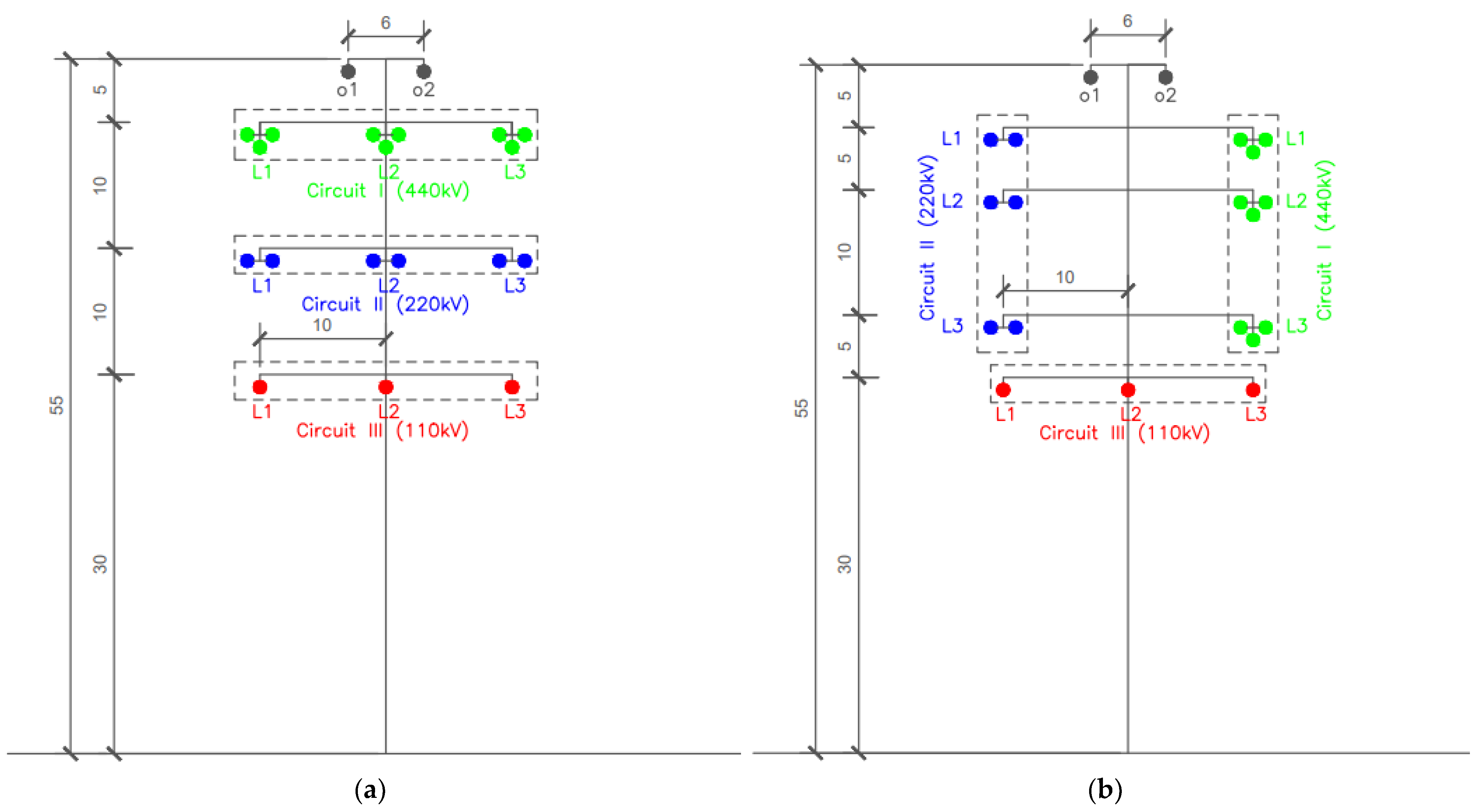
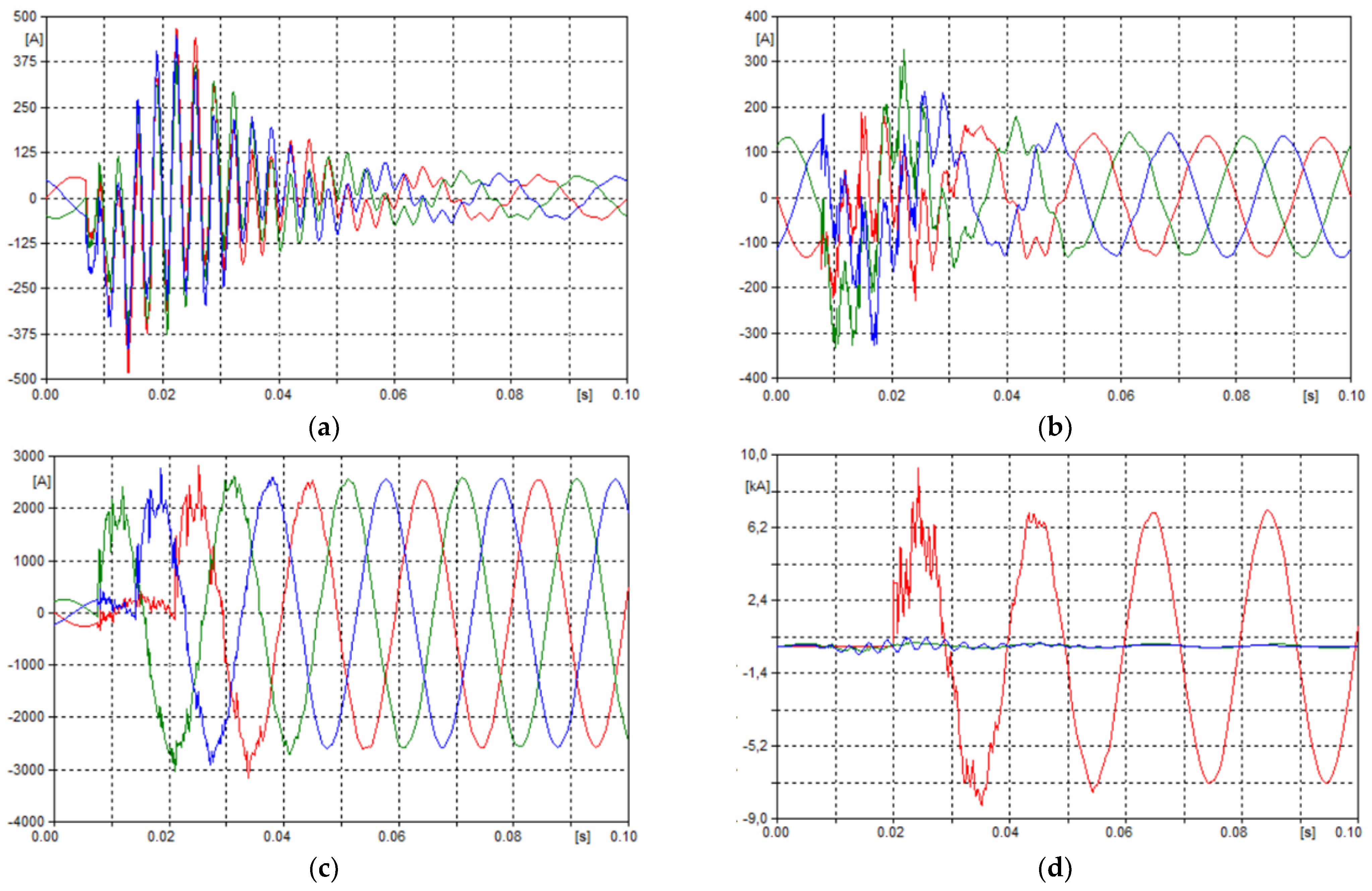
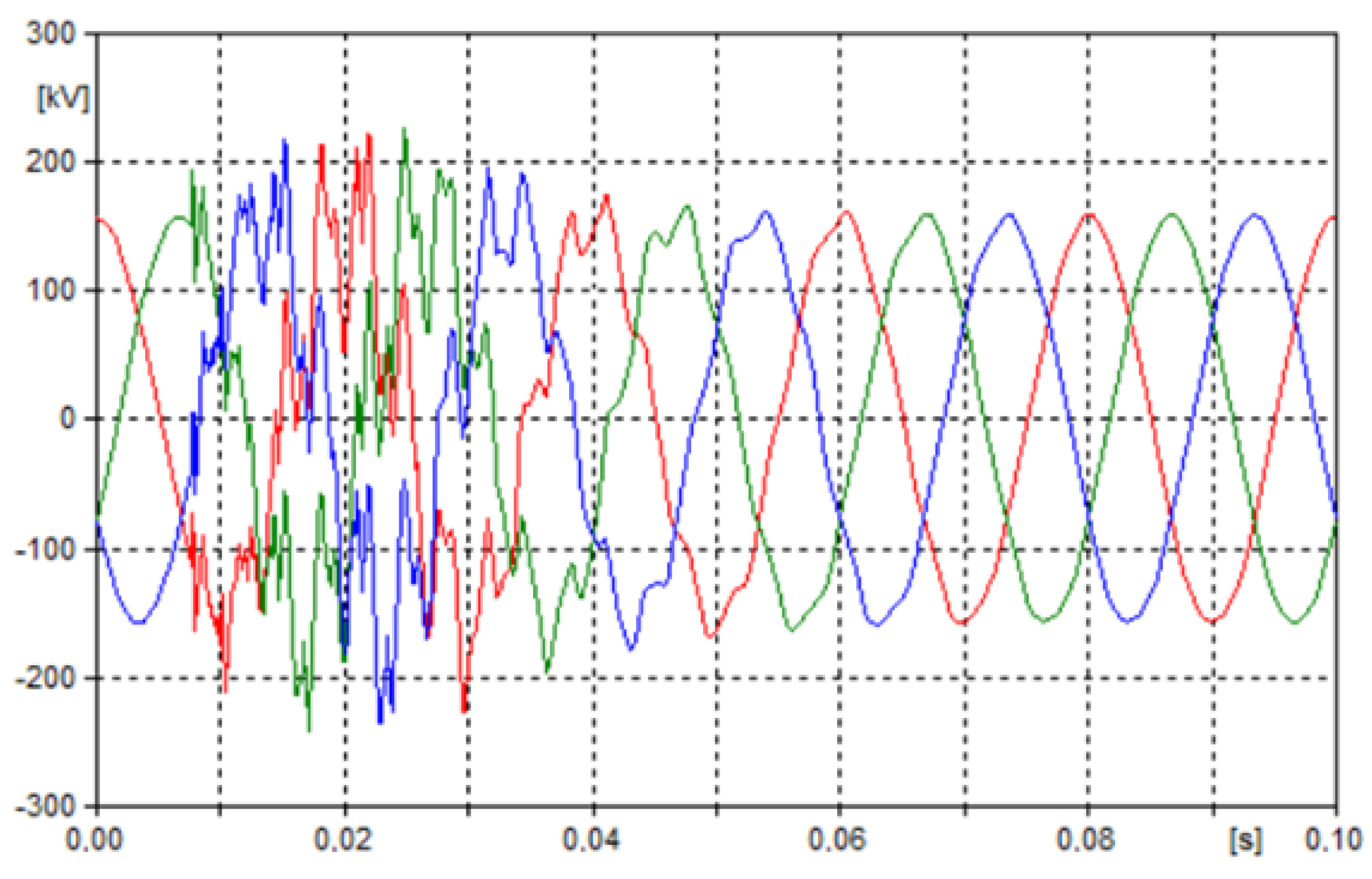
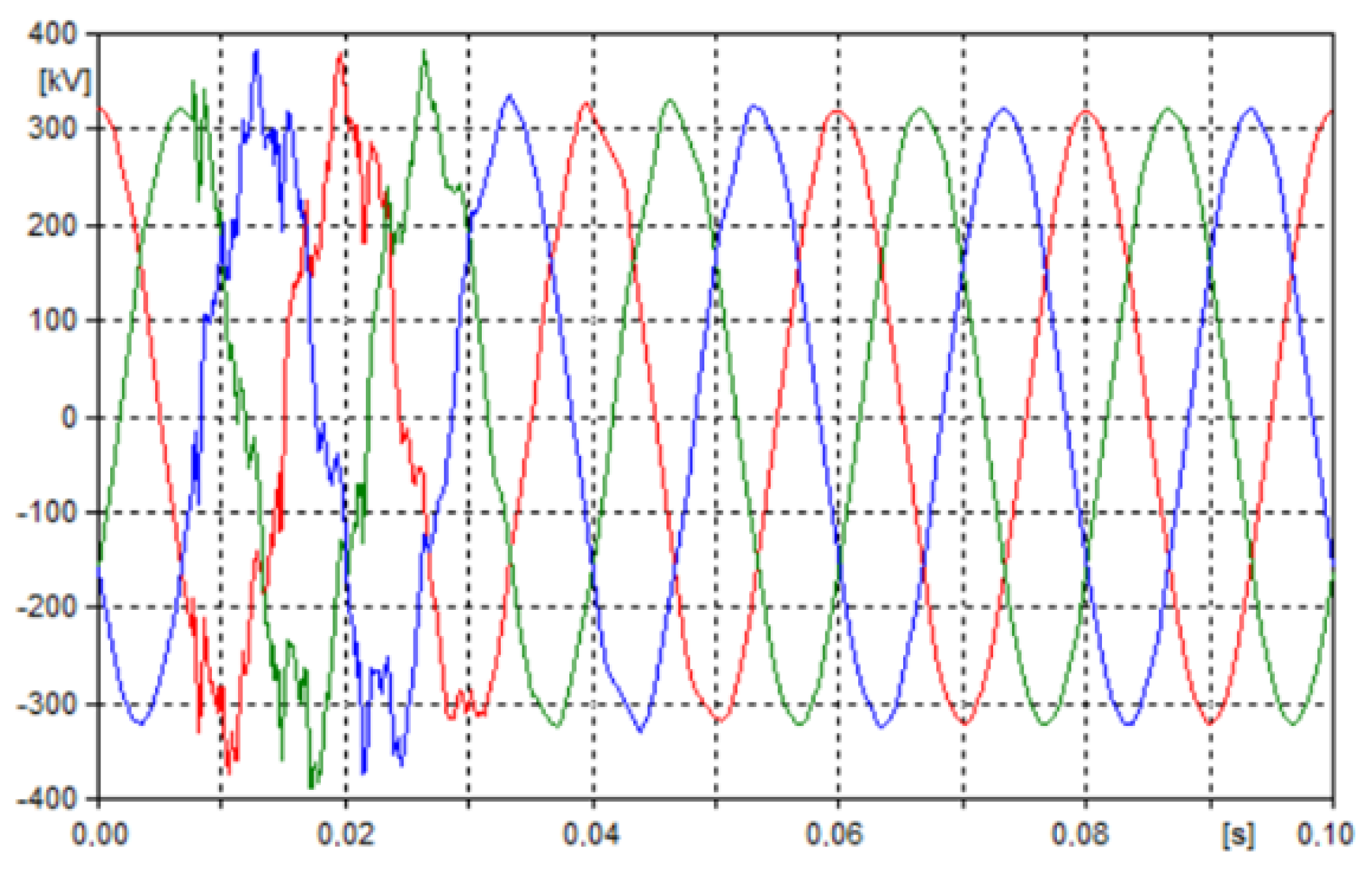

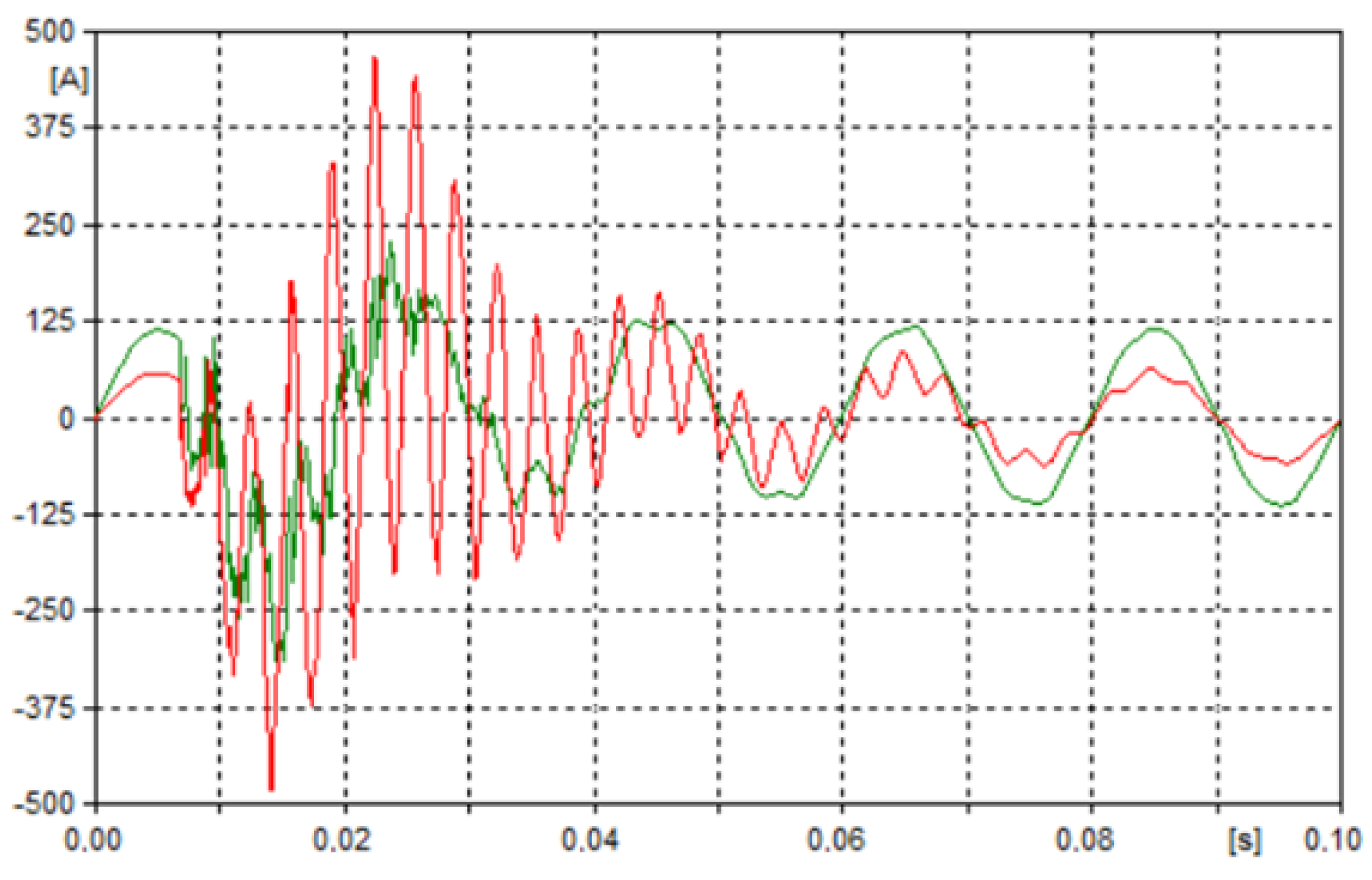
| No. | Type | Overhead Transmission Lines | |
|---|---|---|---|
| kV | Main Solutions | The Width of the Technological Belt | |
| M | |||
| 1. | 220 | 1- or 2-circuit | 50 m (2 × 25) * |
| 2. | 400 | Overhead lines built after 2010 | 70 m (2 × 35) * |
| 3. | 400 | Overhead lines built on a pole of the Z52 series | 60 m (2 × 30) * |
| 4. | 400 | Overhead lines built until 1998 | 80 m (2 × 40) * |
| No. | Parameter | Analysis | ||||
|---|---|---|---|---|---|---|
| Distribution of Short-circuit Currents in Networks with an Earthed Neutral Point | Calculations for Voltage Quality Analyzes | Calculations of Electromechanical Phenomena (Stability Studies) | Short-Circuit and Switching Overvoltages | Research on Input Electromagnetic Signals for Power Protection Automatics | ||
| 1. | Base model | Lumped parameters R, L | The two-port system Π, T or Γ | The two-port system Π, T or Γ | Distributed parameters | Distributed parameters |
| 2. | The dependence of the parameters on the frequency | Negligible | Negligible | Negligible | Very important | Very important |
| 3. | Models transformers | Unnecessary | Unnecessary | Unnecessary | Voltage, capacitive and inductive | Voltage and current transformers including non-linear ones core saturation model |
| No. | Type | Number of Circuits | Rated Voltage | Actual Length of the Multi-Circuit Section |
|---|---|---|---|---|
| kV | km | |||
| 1. | EVH + HV | 3 | 400 + 2 × 110 | 6.5 |
| 2. | EVH + HV | 3 | 2 × 400 + 220 | 4.8 |
| 3. | EHV + HV | 4 | 2 × 400 + 220 + 110 | 31.2 |
| 4. | EHV + HV | 3 | 2 × 400 + 220 | 20 |
| 5. | EHV + HV | 2 | 400 + 110 | 43 |
| 6. | EHV + HV | 2 | 220 + 110 | 7.5 |
| No. | Type | Overhead Transmission Lines | |||
|---|---|---|---|---|---|
| kV | Phase Conductors | Ground Wires | |||
| - | mm2 | - | mm2 | ||
| 1. | 400 | AFL-8 | 3 × 350 | AFL-1.7 | 95 |
| 2. | 220 | AFL-8 | 2 × 350 | ||
| 3. | 110 | AFL-6 | 240 | AFL-1.7 | 70 |
| No. | Type | Multi-Circuit Multi-Voltage HVAC Transmission Lines | |||
|---|---|---|---|---|---|
| kV | Phase Conductors | Ground Wires | |||
| - | mm2 | - | mm2 | ||
| 1. | 400 | AFL-8 | 3 × 350 | AFL-1.7 | 95 |
| 2. | 220 | AFL-8 | 2 × 350 | ||
| 3. | 110 | AFL-6 | 240 | ||
Publisher’s Note: MDPI stays neutral with regard to jurisdictional claims in published maps and institutional affiliations. |
© 2022 by the authors. Licensee MDPI, Basel, Switzerland. This article is an open access article distributed under the terms and conditions of the Creative Commons Attribution (CC BY) license (https://creativecommons.org/licenses/by/4.0/).
Share and Cite
Zychma, D.; Sowa, P. Electromagnetic Transients in Multi-Voltage Transmission Lines during Non-Simultaneous Faults. Energies 2022, 15, 1046. https://doi.org/10.3390/en15031046
Zychma D, Sowa P. Electromagnetic Transients in Multi-Voltage Transmission Lines during Non-Simultaneous Faults. Energies. 2022; 15(3):1046. https://doi.org/10.3390/en15031046
Chicago/Turabian StyleZychma, Daria, and Paweł Sowa. 2022. "Electromagnetic Transients in Multi-Voltage Transmission Lines during Non-Simultaneous Faults" Energies 15, no. 3: 1046. https://doi.org/10.3390/en15031046
APA StyleZychma, D., & Sowa, P. (2022). Electromagnetic Transients in Multi-Voltage Transmission Lines during Non-Simultaneous Faults. Energies, 15(3), 1046. https://doi.org/10.3390/en15031046






